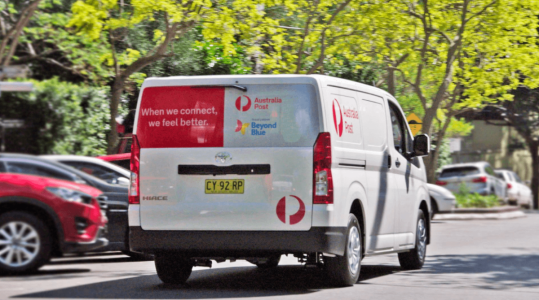Australia Post issues dire warning: Letters could soon become a thing of the past
- Replies 8
Have you ever sat down to write a heartfelt letter to a loved one, only to realise that you haven't touched a pen and paper in months? Or maybe you've come across an old box of letters from your childhood, and the memories they evoke feel like they belong to another era.
This is a story that's becoming all too familiar for many of us as we transition from the written word to digital communications.
Australia Post, the country's largest postal service provider, recently made a worrying prediction: the end of sending and receiving letters may be near.
They expect to post their first full-year loss since 2015, due to the decline of letter writing and the increasing costs of delivering items. The days of eagerly checking the mailbox for a letter from a friend or loved one may soon be a distant memory…

Australia Post has been facing major problems for a while now. Although their parcel business saw an increase during the COVID-19 pandemic, this only temporarily hid the difficulties they were facing.
Now that lockdowns have lifted and the demand for online shopping is returning to normal levels, the real issues at the heart of the business are becoming more noticeable.
Australia Post has recently reported a decline in their letters revenue, with a 5.7% drop compared to the first half of 2022.
Despite a few one-time mailings, including state election materials, interest rate notifications, and cyber-attack notifications, the letter business still lost $189.7 million during the first half of the 2023 financial year (FY23).
Letters now make up a smaller portion of Australia Post's total revenue, with just 18.8% of their income coming from this source, down from 19.5% in the first half of the previous financial year.
In an effort to combat these losses, Australia Post raised the basic postage rate from $1.10 to $1.20 on January 3, 2023, the first increase since 2020. However, this small change is not expected to fully make up for the substantial losses.

Australia Post has also reported a decrease in parcel and services revenue, with $3.80 billion earned during the first half of FY23, a 1.6% drop from the previous year.
But despite this decrease, it's still considered a strong result in a highly competitive market, especially when considering the boost in e-commerce activity seen during the COVID-19 lockdowns.
The profitability of the business was impacted by several factors, including increased costs of wages, severe weather events, and labour shortages. Australia Post absorbed most of the additional costs associated with these unexpected events.
Australia Post's road express and B2B premium service, StarTrack, has continued to see an increase in revenue and managed to maintain a strong performance despite higher costs.
With the decline in letter revenue and slowing growth in parcel deliveries, Australia Post had to come up with a new plan to stay afloat.
The solution? A simplified and streamlined operating model for their corporate support office.
This change is part of a larger effort to respond to financial pressures and ensure that Australia Post remains at the top of the game for e-commerce, digital, mail, and retail services. The new operating model is aligned with the recently launched Post26 strategy and is expected to make a big impact.

Paul Graham, Group's Chief Executive Officer and Managing Director, has recognised the growing challenges that the business is facing and is committed to finding solutions to ensure their success.
'Every year it's costing Australia Post more to deliver fewer letters,' he said. 'We know letters are in an unstoppable decline, thanks largely to digital communications, yet letter costs are rising due to the increasing number of delivery points we service every day.'
'This all contributes to increased losses and is a global issue facing all postal services. We expect annual volumes will decline further, with Australian households receiving less than one letter per week by the end of the decade.'
Australia Post is reportedly at a turning point and the challenges they're facing are tougher than ever before.
As more and more people turn to digital communication, the demand for traditional letters is declining, and costs are on the rise. This, combined with changing customer behaviour, is making it harder for the business to stay afloat.
Mr Graham acknowledged the severity of the situation, saying that they are at a crossroads and that the 'headwinds they're facing are stronger than ever before'.
'As flagged in our 2022 financial results, Australia Post will report a full-year loss this year for the first time since 2015,' said the executive.
With the decline in letters and the shift away from retail transactions at post offices, it's clear that changes need to be made to ensure the long-term financial sustainability of the business to serve customers and communities.
It's not just about survival for Australia Post, but about continuing to provide the best possible service to their customers, even as the world around us continues to evolve.


In a world where emails, texts, and instant messages are the norm, written letters are indeed becoming a rarity.
Remember when getting one in the mail was a big deal? It was exciting to open an envelope and read the words from someone you care about - those moments were special and filled your heart with happiness.
Here at Seniors Discount Club, we know how important letters are – even in the modern age. Does anyone here in the community still send (or receive) letters regularly? And how significant is this announcement for you? Share your thoughts in the comments!
This is a story that's becoming all too familiar for many of us as we transition from the written word to digital communications.
Australia Post, the country's largest postal service provider, recently made a worrying prediction: the end of sending and receiving letters may be near.
They expect to post their first full-year loss since 2015, due to the decline of letter writing and the increasing costs of delivering items. The days of eagerly checking the mailbox for a letter from a friend or loved one may soon be a distant memory…

Australia Post expects that by the end of the decade, the average household will receive less than one letter a week. Credit: Facebook/Australia Post.
Australia Post has been facing major problems for a while now. Although their parcel business saw an increase during the COVID-19 pandemic, this only temporarily hid the difficulties they were facing.
Now that lockdowns have lifted and the demand for online shopping is returning to normal levels, the real issues at the heart of the business are becoming more noticeable.
Australia Post has recently reported a decline in their letters revenue, with a 5.7% drop compared to the first half of 2022.
Despite a few one-time mailings, including state election materials, interest rate notifications, and cyber-attack notifications, the letter business still lost $189.7 million during the first half of the 2023 financial year (FY23).
Letters now make up a smaller portion of Australia Post's total revenue, with just 18.8% of their income coming from this source, down from 19.5% in the first half of the previous financial year.
In an effort to combat these losses, Australia Post raised the basic postage rate from $1.10 to $1.20 on January 3, 2023, the first increase since 2020. However, this small change is not expected to fully make up for the substantial losses.

It appears that the days of receiving letters through the post may be coming to an end. Credit: Unsplash/Natasya Chen.
Australia Post has also reported a decrease in parcel and services revenue, with $3.80 billion earned during the first half of FY23, a 1.6% drop from the previous year.
But despite this decrease, it's still considered a strong result in a highly competitive market, especially when considering the boost in e-commerce activity seen during the COVID-19 lockdowns.
The profitability of the business was impacted by several factors, including increased costs of wages, severe weather events, and labour shortages. Australia Post absorbed most of the additional costs associated with these unexpected events.
Australia Post's road express and B2B premium service, StarTrack, has continued to see an increase in revenue and managed to maintain a strong performance despite higher costs.
With the decline in letter revenue and slowing growth in parcel deliveries, Australia Post had to come up with a new plan to stay afloat.
The solution? A simplified and streamlined operating model for their corporate support office.
This change is part of a larger effort to respond to financial pressures and ensure that Australia Post remains at the top of the game for e-commerce, digital, mail, and retail services. The new operating model is aligned with the recently launched Post26 strategy and is expected to make a big impact.

Australia Post believes the company is at a 'crossroads' and that letter revenue is in an 'unstoppable decline'. Credit: Facebook/Australia Post.
Paul Graham, Group's Chief Executive Officer and Managing Director, has recognised the growing challenges that the business is facing and is committed to finding solutions to ensure their success.
'Every year it's costing Australia Post more to deliver fewer letters,' he said. 'We know letters are in an unstoppable decline, thanks largely to digital communications, yet letter costs are rising due to the increasing number of delivery points we service every day.'
'This all contributes to increased losses and is a global issue facing all postal services. We expect annual volumes will decline further, with Australian households receiving less than one letter per week by the end of the decade.'
Australia Post is reportedly at a turning point and the challenges they're facing are tougher than ever before.
As more and more people turn to digital communication, the demand for traditional letters is declining, and costs are on the rise. This, combined with changing customer behaviour, is making it harder for the business to stay afloat.
Mr Graham acknowledged the severity of the situation, saying that they are at a crossroads and that the 'headwinds they're facing are stronger than ever before'.
'As flagged in our 2022 financial results, Australia Post will report a full-year loss this year for the first time since 2015,' said the executive.
With the decline in letters and the shift away from retail transactions at post offices, it's clear that changes need to be made to ensure the long-term financial sustainability of the business to serve customers and communities.
It's not just about survival for Australia Post, but about continuing to provide the best possible service to their customers, even as the world around us continues to evolve.
Key Takeaways
- In a recent announcement, Australia Post, the country's major postal service provider, expressed concern that letter writing and receiving may soon become a thing of the past.
- Letters are in an 'unstoppable decline' due to digital communications and the cost of delivering them is rising.

In a rapidly changing world, it's easy to get caught up in the convenience and speed of digital communication. Credit: Pexels/Marcus Aurelius.
In a world where emails, texts, and instant messages are the norm, written letters are indeed becoming a rarity.
Remember when getting one in the mail was a big deal? It was exciting to open an envelope and read the words from someone you care about - those moments were special and filled your heart with happiness.
Here at Seniors Discount Club, we know how important letters are – even in the modern age. Does anyone here in the community still send (or receive) letters regularly? And how significant is this announcement for you? Share your thoughts in the comments!







